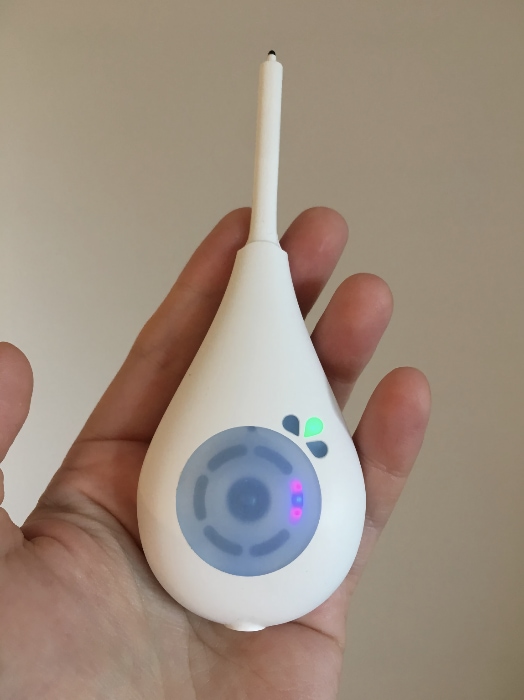As someone who works with women with period problems and who spent thousands of hours learning to become a Natural Family Planning and Fertility Awareness Educator, I am always keen to research and discover different charting methods.
I love the different things that they tell you about your cycle and in all honesty, in many cases, a client who comes in with a few months of charts can give me far more information about their menstrual health to go on, than with tests that may or may not have been done at the right time of the month to be meaningful.
Until recently, I’ve never been a fan of the idea of fertility apps and tech. I’m a huge advocate of women learning about their bodies and and understanding what is going on themselves, but I also get that Fertility Awareness isn’t just something you can pick up. You have to learn it, with an instructor and it does take a few months to learn and understand it properly. This is just not suitable for some women but equally, for many women, going on the pill will make their health and cycles much worse so they are left with rather limited options, so I have been exploring tech options.
Also, as someone who is constantly shown charts on apps with ovulation dates, ovulation predictions and cover-lines that are all over the place (and more often than not wrong), I was very skeptical about all the Fertility Tech out there.
Then I heard about Daysy and that fact that is has been tested and is 99.3% accurate when used properly. So I thought I would give it a try and a year later, I can honestly say it has matched up pretty well to my paper charts. Another bonus it can be synced to an app and give a temperature chart which is still very useful.
What Is Daysy Fertility Monitor?
The simple answer is that Daysy is a device that measures your Basal Body Temperature (BBT) on waking in the morning, like a regular BBT thermometer, however, it also has a traffic light colour coding system.

Red: You are fertile
Yellow: Daysy is still learning your cycle, (if you are trying to avoid pregnancy, most women treat this as red).
Green: Not fertile
Red, Yellow and Green: Pregnant
The purple light in the middle denotes your period.
Super easy to interpret and you can use it to both prevent or plan pregnancy.
I wanted to get to know more about it though, so I spoke to Holly Grigg-Spall from Daysy who also happens to be author of the book Sweetening the Pill or How We Got Hooked on Hormonal Birth Control, a must read for anyone thinking about taking or currently on hormonal birth control.
Green light and period light showing infertile and period day.
Check out the interview below:
Q1: You wrote a great book Sweetening the Pill or How We Got Hooked on Hormonal Birth Control. In the book you advocate for Fertility Awareness education. What made you switch to using Daysy?
Holly: I don’t necessarily see it as a major shift in my thinking or practice. I see Daysy as a tool that offers simplified fertility awareness. While you can just follow the lights and that’s that, most women will naturally become curious and want to know more about their cycle and hormones. That makes Daysy something of a gateway to further body literacy. Many women use Daysy alone, most observe their charts on the app, and some chart their cycles with other apps and/or check their cervical fluid and/or read Taking Charge of Your Fertility. It’s a spectrum, rather than an either/or situation when it comes to learning, education, and the process of becoming body literate. Some women want to know more, but prefer the ease and simplicity of a device day-to-day.
When I wrote my book, I wasn’t aware of Lady-Comp or much fertility tech aside from Kindara. It hadn’t gotten a lot of press attention. Fertility Awareness as a practice for preventing pregnancy wasn’t a focus of the book so I didn’t spend much time researching the options that were becoming or already available in terms of tech. My position in the book was, and always has been, that ALL women should know about their fertility signs and how to track them. It’s essential for informed consent in all decisions to do with reproductive health. However, I don’t believe all women want to or should practice FAM for preventing pregnancy. They might learn this and choose the IUD, condoms, or even the pill – and that’s fine. I think what I call “manual charting” works wonders for some women, but not all. Personally I am glad I have that knowledge, but I found it a) too anxiety-inducing to be overly responsible for keeping tabs on my cycle changes – Daysy lets me feel less anxious about my part in preventing pregnancy b) I have undiagnosed dyscalculia or something like it, i.e. numbers are not my thing and charts are not my thing – it’s not an enjoyable process to me, and if I don’t have to do it, I’m quite happy to skip it!
I’m trying to think of a suitable analogy…so we all know we should eat healthy. Some of us will go to the trouble of cooking a meal from scratch every night and will love doing that. Personally, I don’t enjoy cooking, and if I could have perfectly healthy meals delivered to me every day (and I could afford it) then I would choose that option instead. I’m still trying to eat healthy, I don’t enjoy the process of getting there. If I have to go through the process I will, of course, until I don’t have to!
Q2: Is It Just Another thermometer?
Holly: No, it’s a mini computer with a database of millions of real-life menstrual cycle data. Daysy takes your basal body temperature, stores it, analyzes it comparatively to that database using a unique algorithm and statistical calculations, and then indicates with a color-coded light system if you are able to get pregnant that day or not. So it is a thermometer, with a highly sensitive sensor, but it’s also analyzing that temperature data for you to give your fertility status.
Q3: How does it actually work and how effective is it?
Holly: Daysy learns your unique hormone cycle over the course of 3 cycles – so during that time you’ll get mostly yellow (learning phase) lights. Then, using the internal database of menstrual cycle data, Daysy sets your fertile window prior to the earliest likely point of ovulation based on your cycle data AND the database that provides statistical probabilities. Your fertile window begins with red (fertile) lights, and ends once ovulation is detected via a basal body temperature shift. There’s a caution cushion around this window (red or yellow lights). The window will likely narrow the longer you use Daysy. If you have very regular cycles, don’t miss temps, and have used Daysy for a while, your window could be 7-8 days, but it’s more likely to be 9. Daysy utilizes two data points – menstruation start date and basal body temperature to assume the start of your fertile window and end that fertile window.
Q4: Do I need to use the app too?
Holly: No, you don’t need to use that app – the colour-coded light system on the device itself indicates your fertility status to 99.3% accuracy alone. However, you can use DaysyView to see your charts, share them with your partner, or with a healthcare provider like a doctor, nutritionist, naturopath, or women’s health coach. You can sync with the app every day, every week or just every month. Or never.
Q5: Do I need to do anything else such as chart cervical fluid, symptoms or ovulation predictors tests?
Holly: No, the only two data points Daysy requires are your menstruation start date (always enter the first 3 days of menstruation on the device with the press of a button) and your daily basal body temperature (although you can skip 3 or so temps a month if needed).
Q6: Can women who do shift work use it?
Holly: Yes, as you only need 3 consecutive hours of sleep to use Daysy and gain an accurate reading. Plus you don’t need to use Daysy at the same time every day – you need 18 hours between readings minimum but that’s all that’s required. So you can work shifts, sleep in, have a disruptive kid/pet/partner and still use Daysy!
My Final Thoughts
I have been using Daysy for a year and I am confident it matches up with my manual charts, so I am no longer skeptical. I also love that it offers one of the few tried and tested “temp and go” options that, unlike hormonal birth control, has no side effects.
I love the new direction that Femme Tech and Fertility Tech is going and this is another option for women who want some kind of reliable method without the hassle of learning manual cycle charting, which they can go onto later if they are still interested.
If you’re in Europe, you can order your Daysy here.
If you’re in the US, you can order your Daysy here.




